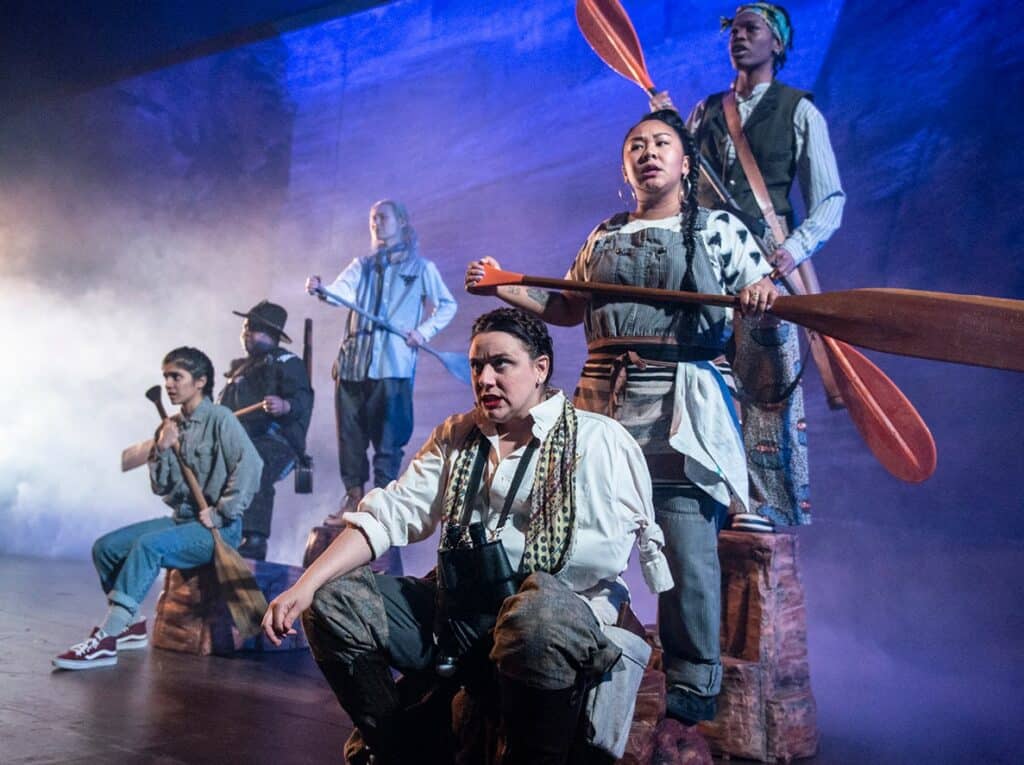New Modes of Representation Forcing Reexamination of Oldtime Heroes: MEN ON BOATS at Baltimore Center Stage

Posted on BroadwayWorld.com December 9, 2019
Jaclyn Backhaus’s Men on Boats, now appearing at Baltimore Center Stage, is a gently amiable but persistently subversive take on America’s age of exploration. It recreates the 1869 expedition of John Wesley Powell and nine others down the Green and Colorado Rivers and into the Grand Canyon on a presidentially-ordained voyage of discovery. As the play is at pains to show us, the trip was a voyage of discovery only from the perspective of certain white Protestant men, since Native Americans lived along the route – and white Mormons dwelt close by as well. But only when the river and surrounding lands were surveyed and mapped by certain kinds of white men could they truly be considered part of the American imperium. While the travelers can acknowledge that various people “have run these streams” before them, including “natives” and military deserters, these predecessors were persons whom “no one counts.” That laughably foreshortened perspective does not rob the travelers of bravery, resilience, or grit. It just makes their heroic sacrifices less consequential than they understand.
It is Backhaus’s notion, however, to present these quintessential American white males of the Old West with an ethnically diverse cast in which no men appear, speaking to each other in the diction of today’s Millennials. (Thus a Ute describing land negotiations with the white people explains: “Yeah it was cool. They let us keep our birth lands, so we were pretty stoked.”) Having a diverse crew of women conversing in the argot of a relatively woke generation while articulating views that make no room for the significant agency of women or nonwhites underlines how misguided those views are.
There is a contemporary quasi-political significance to such casting as well. In a press release announcing the play, Baltimore Center Stage’s Artistic Director Stephanie Ybarra stated: “At this moment in history, it feels especially pertinent to decenter men in our storytelling, not just onstage, but behind-the-scenes and backstage too.” If I were Baltimore Center Stage’s employment counsel, I’d be a little worried about the job discrimination exposure courted by such language. But the dramatic effect of wiping men completely off the stage in a play about men is clear. Recreation of the stage as a female space (or at least a space where all of the performers are either women or non-gender-identified) is a powerful thing. Scholar Gemma Miller has noted that casting women in men’s roles questions the authority of male authors, “challenges the hegemony of male-dominated theatrical institutions, and disrupts culturally embedded ideas of gender hierarchies.” This probably goes in spades when all the roles are nominally male ones. And similarly as to nominally white roles being filled by an ethnically diverse cast (as Hamilton has taught us). Backhaus and Ybarra are obviously out to stick pins in male-flavored grandiosity, imperialism, white supremacy, etc. Denying males representation on the stage (as women and non-whites have traditionally been denied representation) is an effective way to do it.
On a temporary basis, that is, it’s effective. As a permanent state of affairs, it would be unworkable and unnecessary. The ethos of diversity has taken hold in most corners of Maryland theater. And as a partly tax-supported entity legislatively designed as a State Theater of Maryland, Baltimore Center Stage, at some point owes allegiance (and representation and employment opportunities) to all Marylanders, including male ones. We can all acknowledge that Center Stage used to fall with distressing consistency off the opposite side of the horse; in my first season following the company, 1971-72, for example, the artistic director, all of the playwrights, and all of the directors were white males. But a permanent inversion of that gender imbalance would only leave a different imbalance. A theater which was only a theater of the previously marginalized would still be a theater that marginalizes.
I said in the lede that the play is gently amiable, and I think that quality owes much to a genuine admiration for the somewhat misguided men whose journey it chronicles, and for the overall trajectory of that journey as well. It is a tribute to what may justly be called the choreography of director Jenny Koons and assistant director Toni Rae Salmi, and to the ten members of the cast that, although the staging of a rapids-tossed and waterfall-prone boat voyage will perforce require the active cooperation of the audience’s imagination, we all emerge from watching the oarsmanship and the bracing for shocks and the tossing of lifelines with a lot of belief. We feel we’ve observed it, and it looks like a feat any voyager could be proud of. And so is the fortitude and reflectiveness of even the least reasonable members of the crew. There can be something deeply disturbing about the travelers’ imperialistic venture and their eagerness to name after themselves geographic landmarks that the Native Americans doubtless has already given names. But that only lends piquancy to their likeability.
Moreover, it is no accident that the voyage ends in the Grand Canyon, i.e. in a place where the action, the mood, and even the visual frame all broaden out and lighten up. Scenic designer Stephanie Osin Cohen and assistant scenic designer Susannah Hyde deserve much credit for presenting the voyage, and particularly its end, in stunning fashion.
In these respects, the play exhibits a number of eerie correspondences with Eric Overmyer’s On The Verge or the Geography of Yearning, which premiered at Center Stage in 1985 and received a terrific revival down the road at the REP in 2010, a play which followed three indefatigable female explorers from the coast of Peru in the year 1888 into a world of miraculous and wondrous objects, a world which turns out to be the future, our modern world. Like the explorers of Men on Boats, the travelers of On the Verge may be burdened with a strange conception of the meaning of their voyage, conditioned by the social privilege they begin with, a misapprehension which never leaves them, but their pluck and the delight with which they admire the world they find does much to redeem them.
The conclusion of Men on Boats is more sardonic than that of Overmyer’s play, and not just because of the long shadows of racism and imperialism over the nature of the Powell expedition’s quest; not all of Backhaus’s travelers make it, and of those that do, it is prophesied by a character who has seen the future, few will lead celebrated or necessarily even happy lives. But they have reached the point where at least they can say, along with the poet Dryden: “Tomorrow do thy worst, for I have lived today.” That kind of triumph can be enough, for characters and for audience.
The cast is admirable throughout. As John Wesley Powell, the one-armed Civil War veteran leading the expedition, Ceci Fernandez evinces an interesting mixture of leadership and vulnerability (the latter highlighted when Powell first rejects help, then must ask for it, where one unassisted arm will not save him from a hazard). I loved Haruna Lee’s turn as Old Shady, Powell’s laconic brother who gives few clues as to his thoughts or reactions, but periodically suddenly bursts into song. I admired Keren Lugo, especially in a doubling role, that of a mockingly generous Native American leader, although I had no quarrel either with her principal role, a mountain man named O.G. Howland. And Natalie Woolams-Torres amuses greatly as Frank Goodman, a British explorer along on a lark, who also possesses fortitude even when losing his trousers, tempered by knowledge of his limits. Again, mention of some cast members implies no disparagement of the others.
Overall, this play is a welcome addition to the ongoing critical reexamination of the Old West and that of contemporary patriarchy and racism – and an amusing evening of theater. Highly recommended.
Copyright (C) Jack L. B. Gohn, except for production photo.
Photo credit: Theresa Castracane

 I lived in London and Vienna before coming to the United States, and grew up mainly in Ann Arbor. I was writing plays and stories as early as grade school. My undergraduate years at the University of Pennsylvania, where I first reviewed theater, for the college paper, were succeeded by graduate study at the Johns Hopkins University, where I earned a doctorate in English Literature.
I lived in London and Vienna before coming to the United States, and grew up mainly in Ann Arbor. I was writing plays and stories as early as grade school. My undergraduate years at the University of Pennsylvania, where I first reviewed theater, for the college paper, were succeeded by graduate study at the Johns Hopkins University, where I earned a doctorate in English Literature.